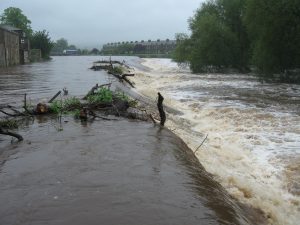Can we deliver 300,000 new homes a year without exacerbating the strain on urban surface water flooding infrastructure that is already struggling to cope in some areas? Matthew Elliot of WYG takes a look
In June 2007, over 8,000 houses and 1,000 businesses were flooded in Hull and the surrounding areas. The flooding was not from the River Hull, nor from the Humber Estuary; primarily it was because the urban drainage system was overwhelmed.
The floods drew national attention to the issue of surface water flooding and the Pitt Review (2008), published in the aftermath, highlighted the “fragmented” nature of flood risk management in England.
The resultant 2010 Flood & Water Management Act (FWMA) was intended to address this fragmentation.
Central to the new legislation was the creation of ‘risk authorities’, in particular, Lead Local Flood Risk Authorities (LLFA) (county councils and unitary authorities), who as a result now hold responsibility for ‘local sources’ of flood risk. In effect, responsibility for ‘local’ flood issues such as surface water, ordinary watercourses and groundwater was transferred from the Environment Agency (EA) to these new LLFAs.
Given the UK’s housing crisis, the LLFAs have a very significant role to play if 300,000 homes are to be provided each year without swamping the already strained ‘local’ urban surface water drainage infrastructure.
Planning guidance was amended in April 2015 that made LLFAs statutory consultees in the planning process. The six-year programme of flood defence projects funded by Flood Defence Grant in Aid (FDGiA) now includes schemes put forward by LLFAs to tackle existing local urban surface water flooding problems and we now have national surface water flooding maps, first published by the EA in 2012.
 However, back in 2010, LLFAs generally did not have strong capabilities in flood risk management. The period since 2010 has been one of austerity for local government with technical staff, who were widely co-opted into the new LLFA flood risk management teams, under threat of redundancy.
However, back in 2010, LLFAs generally did not have strong capabilities in flood risk management. The period since 2010 has been one of austerity for local government with technical staff, who were widely co-opted into the new LLFA flood risk management teams, under threat of redundancy.
Although various capability-raising initiatives have been launched by the government, continuing skills shortages and funding problems present major challenges to the LLFAs, who have a role of growing significance.
Furthermore, the LLFAs, without a national centralised structure like the EA, have a significant diversity of approaches to the management of surface water flooding issues associated with new development in each administrative area. For instance, some LLFAs will adopt Sustainable Drainage Schemes (SuDS), some won’t; some have clear development control policies, others appear to provide extremely precautionary ad hoc responses while overlooking potentially significant issues. This is clearly not an ideal regulatory context in which to deliver 300,000 new houses per year.
Furthermore, the widespread implementation of SuDS, a key part of the Pitt Review recommendations, remains frustrated by issues arising from stakeholder fragmentation. For instance, Schedule 3 (Sustainable Drainage) of the F&WM Act 2010 is yet to be implemented.
Although SuDS are not the panacea to all urban surface water flooding problems as some believe, they do make a positive contribution and are a specific requirement of the National Planning Policy Framework (NPPF) and many local planning policies. However, with mixed approaches from LLFAs on how to adopt SuDS and a failure as yet for water utilities (also ‘Risk Authorities’ established by the F&WMA 2010) to embrace SuDS, the result is widespread frustration in the housebuilding sector.
If surface water flows cannot be attenuated and cleansed by these SuDS, the future of new estate roads by highway authorities (also ‘Risk Authorities’ established by the F&WMA 2010) is potentially jeopardised, which may have major legal and long-term implications for developers and future householders.
So, can 300,000 new housing units per annum be delivered without exacerbating the strain on existing urban surface water flooding infrastructure?
 In some cases, unpopular development of greenfield sites on the urban fringe can be designed to discharge cleansed and attenuated run-off into watercourses without increasing downstream flood risk. In some favoured locations infiltration is an attractive solution.
In some cases, unpopular development of greenfield sites on the urban fringe can be designed to discharge cleansed and attenuated run-off into watercourses without increasing downstream flood risk. In some favoured locations infiltration is an attractive solution.
However, as our towns and cities typically originated on the banks of rivers and have spread outwards and upwards, much greenfield land must discharge into older urban areas where the drainage infrastructure was never designed in contemplation of the major urban expansion now required.
Redevelopment of former industrial land does offer the opportunity to replace vast hard paved areas with new, ‘greener’ developments thus reducing downstream run-off. Similarly, tired older housing schemes that relied on combined drainage schemes can be replaced or redeveloped incorporating SuDS approaches, again bringing downstream benefits.
However, until LLFAs’ flood management teams receive the resourcing required to deepen both their capacity and capability to deal with their growing role, there will be much frustration amongst housebuilders as new schemes become mired in planning issues associated with ‘local flooding’.
Similarly, implementation of housing will continue to be hampered by ill-considered planning conditions that may or may not be appropriately implemented in practice. Until LLFAs, water utilities or other risk authorities more widely and consistently step up to adopt SuDS, it will continue to be necessary for housebuilders to use their own management companies to maintain these vital and sensitive features of the emerging contemporary urban drainage scene. This is hardly the end to the fragmentation that the FWM Act was intended to address, nor the ideal context for the smooth delivery of 300,000 new houses per year.
Summer is the season of thunderstorms when high intensity, short duration rain can be expected. This is the type of rainfall that exposes the weaknesses in the local urban drainage systems. Typically, the problems caused by such incidents do not get widespread publicity as they are local events. They nevertheless cause untold misery.
We can build 300,000 new homes per year and we can manage the associated ‘local’ flood risks; but only if the LLFAs have the necessary resources to undertake their important role of managing local flood risks operating in full coordination with the other risk authorities.
Matthew Elliott
Director – Engineering
WYG
Tel: +44 (0)113 2192554
Twitter: @wyggroup














